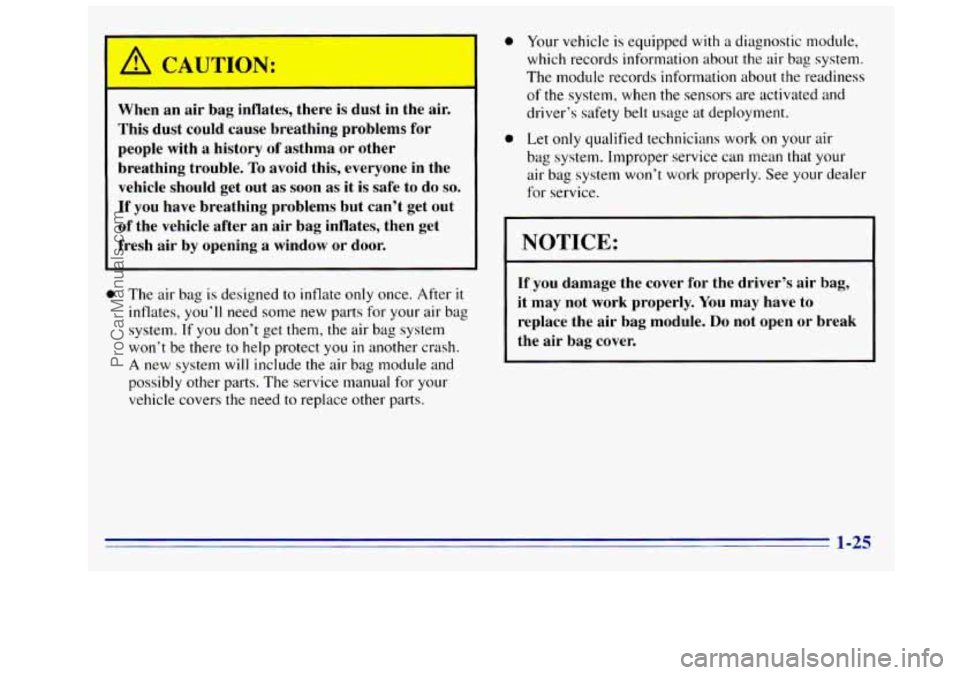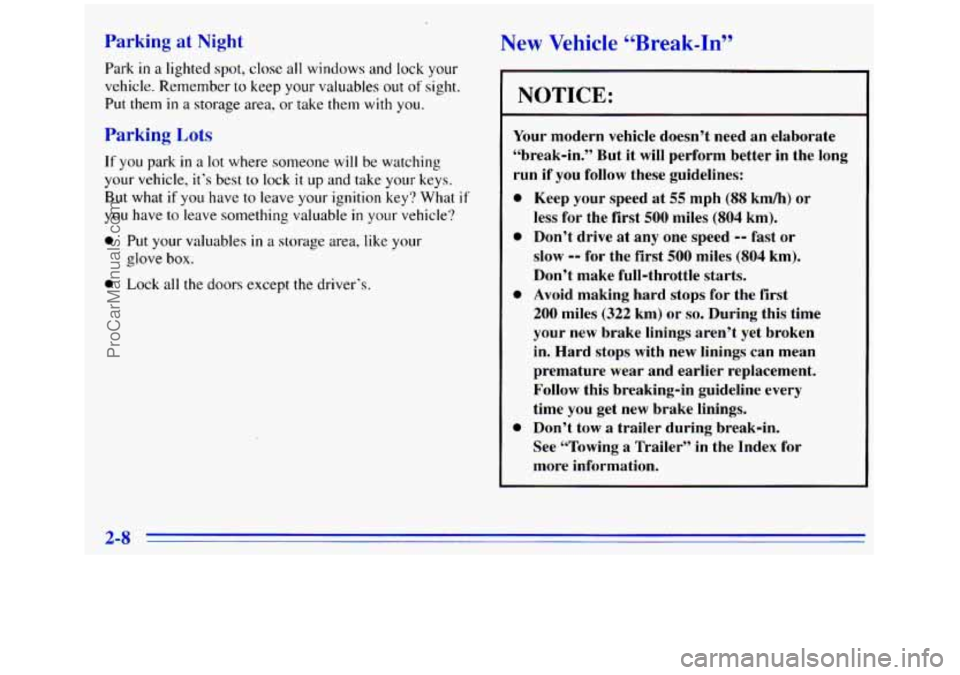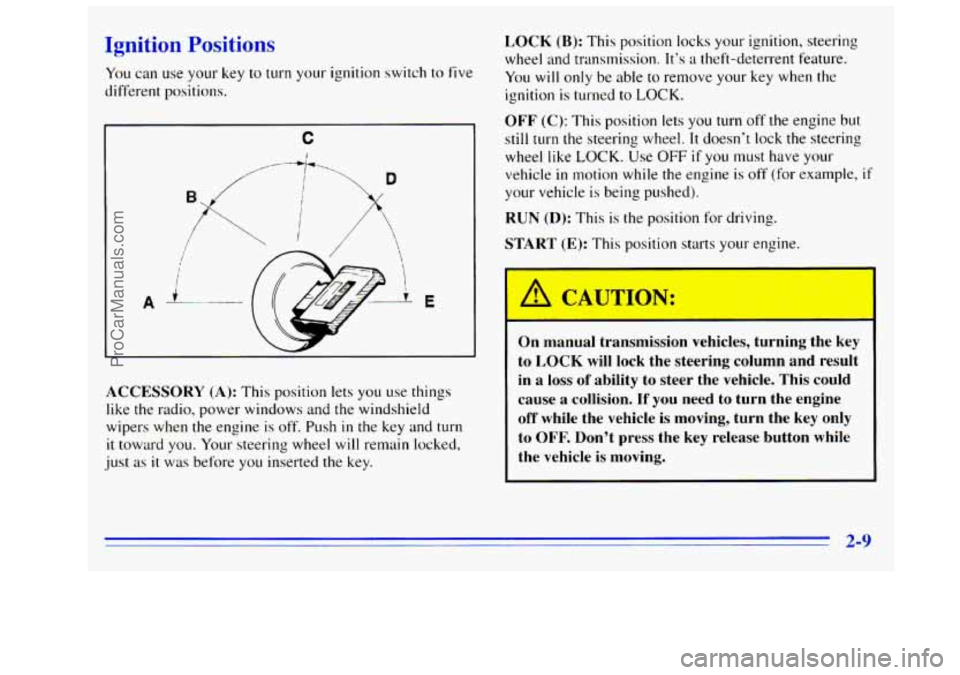Page 7 of 404
Vehicle Symbols
These are some of the symbols you may find on your vehicle.
For example,
these symbols
are used on an
original battery:
POSSIBLE A
CAUTION
INJURY
PROTECT EYES BY
SHIELDING
CAUSTIC
ACID COULD BATTERY
CAUSE
BURNS
These symbols
are important
for you and
your passengers
whenever your
vehicle is
driven:
DOOR LOCK
UNLOCK
FASTEN SEAT
BELTS
These symbols
have
to do with
your lights:
SIGNALS e e3
TURN
WARNING
A
HAZARD
FLASHER
These symbols are
on some of
your controls:
WINDSHIELD
DEFROSTER
These symbols are used on
warning and
indicator lights:
COOLANT
TEMP
-
CHARGING I-1
BAllERY
SYSTEM
BRAKE
(0)
Here are some
other symbols
you may see:
FUSE
LIGHTER
AVOID
SPARKS
OR
FLAMES
SPARK
OR ,\I/,
COULD FLAME
EXPLODE BATTERY POWER
WINDOW RUNNING
0
DAYTIME -
LAMPS '*'
FOG LAMPS # 0
VENTILATING
FAN
1
-3
COOLANT a
ENGINE OIL e,
PRESSURE HORN
)tr
SPEAKER v
FUEL B
V
ProCarManuals.com
Page 33 of 404

1 a CAUTION:
When an air bag inflates, there is dust in the air.
This dust could cause breathing problems for
people with
a history of asthma or other
breathing trouble.
To avoid this, everyone in the
vehicle should get out as
soon as it is safe to do so.
If you have breathing problems but can’t get out
of the vehicle after an air bag inflates, then get
fresh air by opening
a window or door.
0 The air bag is designed to inflate only once. After it
inflates, you’ll need some new parts for your air bag
system.
If you don’t get them, the air bag system
won’t be there
to help protect you in another crash.
A new system will include the air bag module and
possibly other parts.
The service manual for your
vehicle covers
the need to replace other parts.
0
0
Your vehicle is equipped with a diagnostic module,
which records information about the air bag system.
The module records information about the readiness
of the system, when the sensors are activated and
driver’s safety belt usage at deployment.
Let
only qualified technicians work on your air
bag system. Improper service can mean that your
air bag system won’t work properly. See your dealer
for service.
NOTICE:
If you damage the cover for the driver’s air bag,
it may not work properly. You may have to
replace the air bag module.
Do not open or break
the air bag cover.
1-25
ProCarManuals.com
Page 39 of 404
Lap-Shoulder Belt (Extended Cab)
The positions next to the windows have lap-shoulder
belts. Here’s how
to wear one properly.
1. Pick up the latch plate and pull the belt across you.
2. Push the latch plate into the buckle until it clicks.
Don’t let
it get twisted. If
the belt stops before it reaches the buckle, tilt the latch
plate and keep pulling until
you can buckle it.
Pull up on the latch plate
to make sure it is secure.
If the belt is not long enough, see “Safety Belt
Extender” at the end
of this section.
Make sure the release button
on the buckle is positioned
so you would be able to unbuckle the safety belt quickly
if you ever had to.
~~ 1-31
ProCarManuals.com
Page 42 of 404
Lap-Shoulder Belt (Crew Cab)
The positions next to the windows have lap-shoulder
~ belts. Here’s how to wear
one properly.
1.
2.
t
Pick up the latch plate and pull the belt. across you.
Don’t let
it get twisted.
Push the latch plate into the buckle until it clicks. Pull
up
on the latch plate to make sure it is secure. When
the lap belt is pulled out all the way,
it will lock. If it
does, let it go back all the way and start again.
If the belt is not long enough, see “Safety Belt
Extender” at the end
of this section.
Make sure the release button
on the buckle is
positioned
so you would be able to unbuckle the
safety belt quickly if
you ever had to.
1 1-34
ProCarManuals.com
Page 57 of 404
en
Children who have outgrown child restraints should
wear the vehicle’s safety belts.
If you have the choice, a child should sit next to a
window so the child can wear a lap-shoulder belt and
get the additional restraint
a shoulder belt can provide.
Accident statistics show that children are safer
if they
are restrained in the rear seat. But they need to use the
safety belts properly.
0 Children who aren’t buckled up can be thrown out in
a crash.
0 Children who aren’t buckled up can strike other
people
who are.
1-49
ProCarManuals.com
Page 63 of 404
Section 2 Features and Controls
Here you can learn .about the many standard and
optional features on your vehicle, and information
on
starting, shifting and braking. Also explained are the
instrument panel and the warning systems that tell you if
everything is working properly
-- and what to do if you
have a problem.
Keys
Leaving young children in a vehicle with the
ignition key is dangerous for many reasons.
A child or others could- be badly injured or
even killed.
They could operate power windows or other
controls
or even make the vehicle move. Don’t
leave the keys in a vehicle with young children.
2-1
ProCarManuals.com
Page 70 of 404

Parking at Night New Vehicle “Break-In”
Park in a lighted spot, close all windows and lock your
vehicle. Remember
to keep your valuables out of sight.
Put
them in a storage area, or take them with you.
Parking Lots
If you park in a lot where someone will be watching
your vehicle, it’s best
to lock it up and take your keys.
But what if you have to leave your ignition key? What if
you have to leave something valuable in your vehicle?
0 Put your valuables in a storage area, like your
glove
box.
0 Lock all the doors except the driver‘s.
NOTICE:
Your modern vehicle doesn’t need an elaborate
“break-in.” But it
will perform better in the long
run
if you follow these guidelines:
0
0
0
0
Keep your speed at 55 mph (88 km/h) or
less for the first
500 miles (804 km).
Don’t drive at any one speed
-- fast or
slow
-- for the first 500 miles (804 km).
Don’t make full-throttle starts.
Avoid making hard stops for the
first
200 miles (322 km) or so. During this time
your new brake linings aren’t yet broken
in. Hard stops with new linings can mean
premature wear and earlier replacement.
Follow this breaking-in guideline every
time you get new brake linings.
Don’t tow a trailer during break-in.
See “Towing
a Trailer” in the Index for
more information.
2-8
ProCarManuals.com
Page 71 of 404

Ignition Positions
You can use your Key to turn your ignition switch to five
different positions.
C
1
E
W
LCCESSORY (A): This position lets you use things
like the radio, power windows and the windshield
wipers when the engine is off. Push
in the key and turn
it toward you. Your steering wheel will remain locked,
just
as it was before you inserted the key. LOCK
(B): This
position locks your ignition, steering
wheel
and transmission. It's a theft-deterrent feature.
You will only be able to remove your key when the
ignition is turned to
LOCK.
OFF (C): This position lets you turn off the engine but
still
turn the steering wheel. It doesn't lock the steering
wheel like
LOCK. Use OFF if you must have your
vehicle in motion while the engine is off (for example, if
your vehicle is being pushed).
RUN
(D): This is the position for driving.
START
(E): This position starts your engine.
I
I A CAUTION:
On manual transmission vehicles, turning the key
to LOCK will lock the steering column and result
in
a loss of ability to steer the vehicle. This could
cause
a collision. If you need to turn the engine
off' while the vehicle is moving, turn the key only
to
OFF. Don't press the key release button while
the vehicle is moving.
ProCarManuals.com